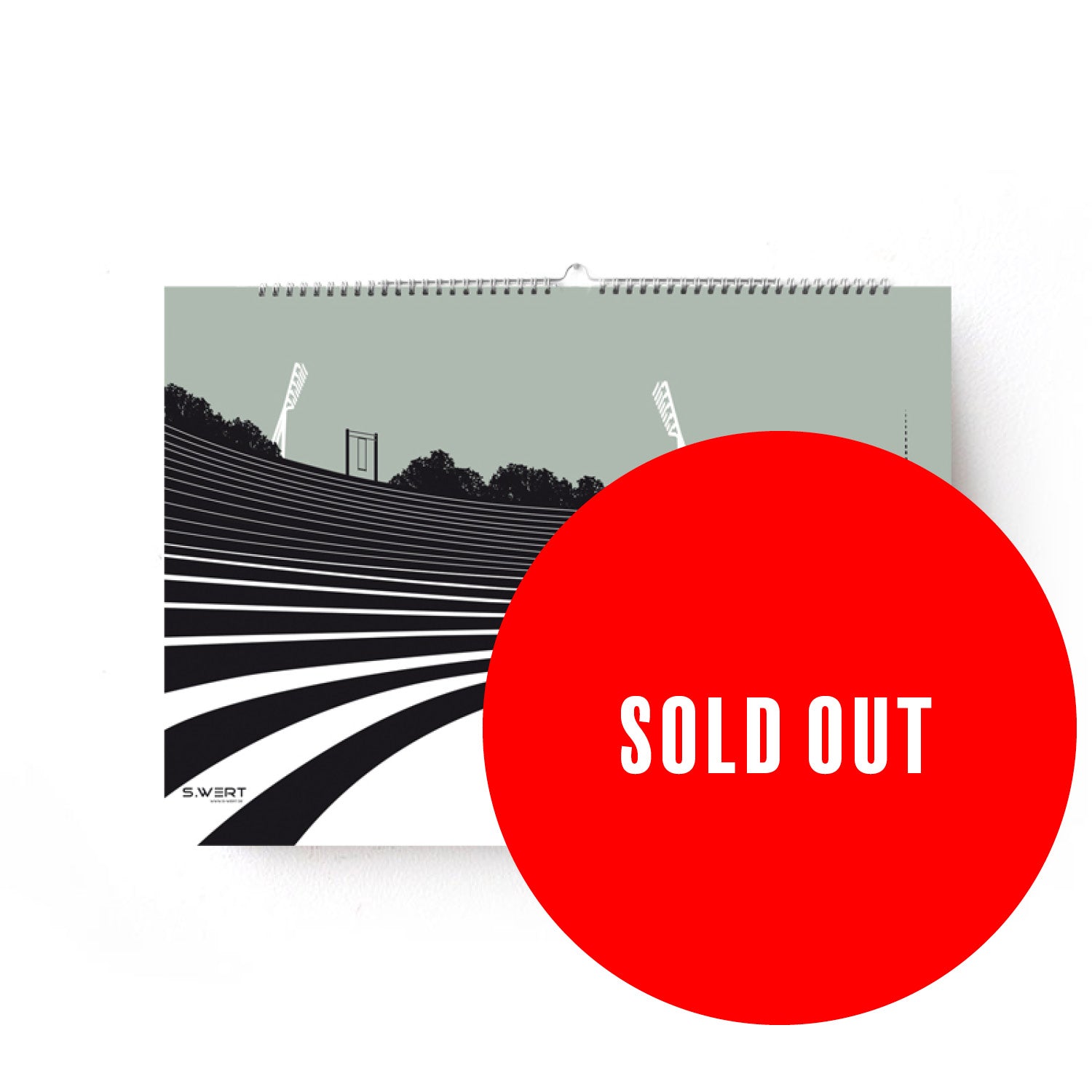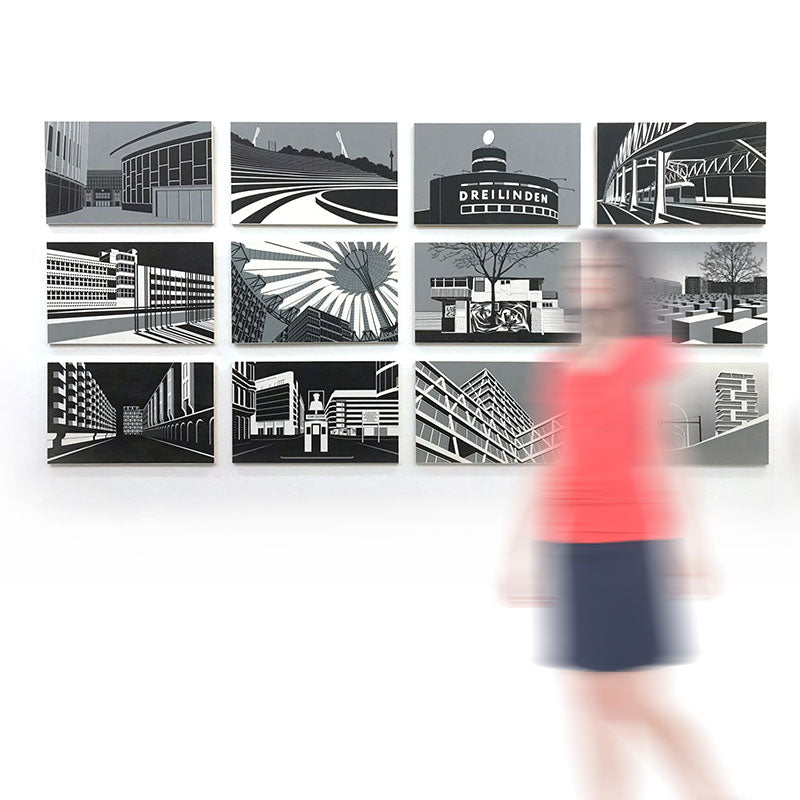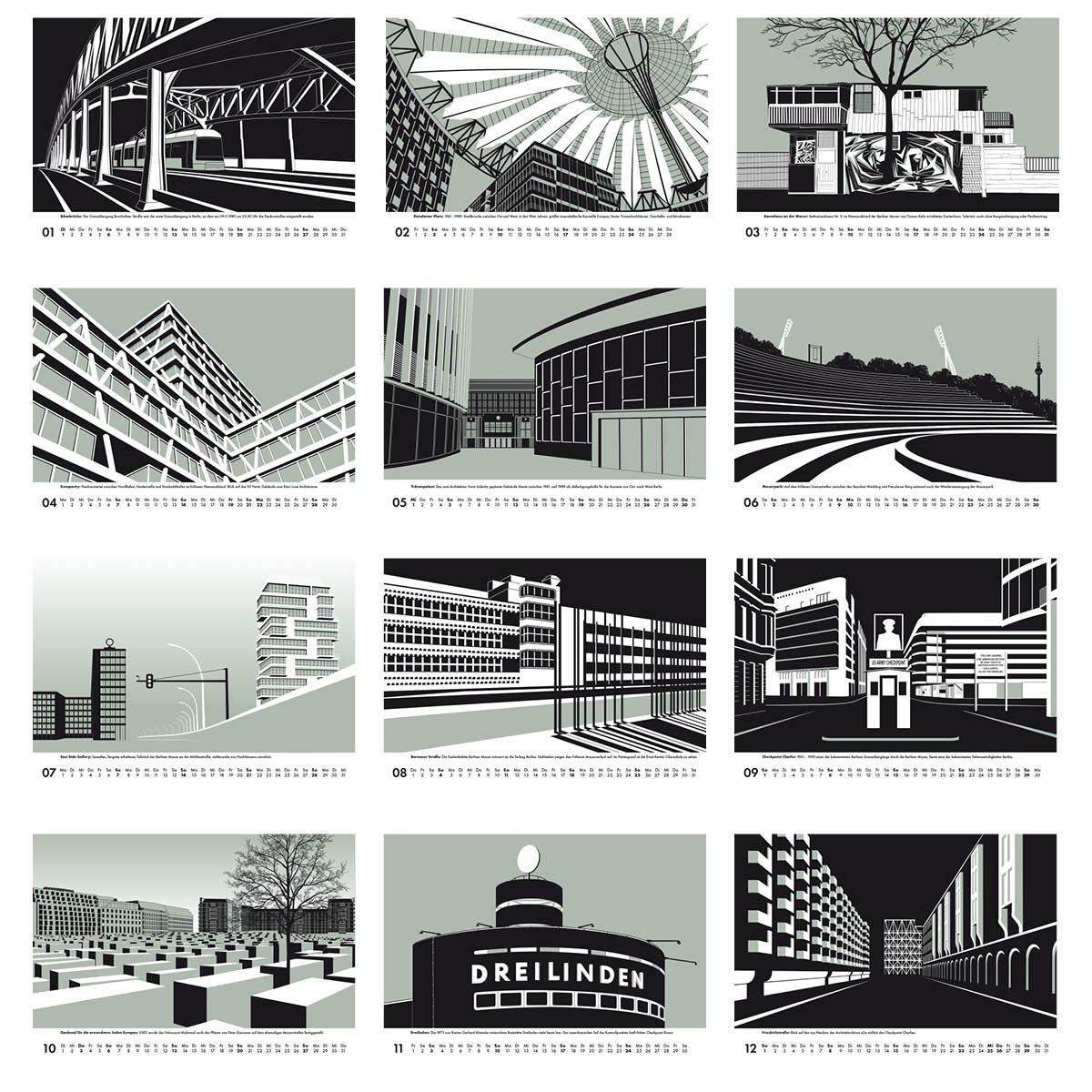s.wert
Berlin Calendar 2019: No Wall
Berlin Calendar 2019: No Wall
Couldn't load pickup availability
In 2019 it will be 30 years since the Berlin Wall fell and that is why we have made the Berlin Wall, or places and buildings along the former border, the subject of the s.wert wall calendar 2019. The graphic calendar is also an inventory of how Berlin dealt with the open spaces that existed after 1989.
January will start with a dynamic graphic of the Bösebrücke with a tram. The Bornholmer Strasse border crossing was the first border crossing to open on November 9 at 11:30 p.m. It's nice that the trams are passing through here again.
In the shadow of the Berlin Wall, one of Berlin's first guerrilla gardens was created in Kreuzberg - the "Tree House on the Wall". It is a shack with a large vegetable garden on a traffic island on Bethaniendamm. Today it would be called "Upcycling Tiny House" or "Micro Urban Garden Home". The calendar graphic in March is dedicated to the unusual garden house that Osman Kalin from Kreuzberg created on GDR territory. The black building is tolerated by the district. The property now belongs to the family of the initiator, who died in 2018, and they would like to turn it into a museum.
Thirty years after the fall of the Berlin Wall, what used to be inner-city no man's land is still being built on. Gone are the days when investors had to be wooed with elaborate showpiece productions. The currently largest area is between Nordhafen, Heidestraße and Humboldthafen and bears the interchangeable name Europacity. Also in Frankfurt, Stuttgart, near Paris and Munich, new development areas are being built, which are called Europaviertel. Hopefully there won't be any confusion.
A “Quarter of the Future” is to be created on Heidestrasse. The future - in Berlin's Europacity, these are mostly homogeneous blocks with gridded facades in the Excel spreadsheet look and sounding, well marketable names.
One of the most interesting buildings with a dynamic facade thanks to the external supporting structure was created by the Graz architects "LOVE architecture and urbanism" for the headquarters of the transmission system operator "50Hertz".
1962 – just one year after the Wall was built, the check-in hall at Friedrichstraße station went into operation. The transparent glass and steel construction by the architect Horst Lüderitz was originally planned as a reception building. In fact, the pavilion was then used to emigrate from East to West Berlin - so the building was given the name "Palace of Tears". The GDR prestige building is now a listed building and is an exhibition space. The exhibition “Border Experiences. Everyday life of the German division” documents fates around the Palace of Tears.
After reunification, the Mauerpark was created on the death strip between Prenzlauer Berg and Wedding. Giant swings stand in front of the remains of the hinterland wall, the remains of the wall itself are a design area for graffiti artists and those who would like to become one. On Sundays, the site is transformed into a big open-air spectacle with a flea market, street food, capoiera and karaoke. The calendar graphic shows the amphitheater, whose tiers are always packed on Sunday afternoons, because Joe Hatchiban hosts karaoke with cult status on the stage.
"The wall has to go" - that was the call for freedom in 1989. Since 1991, the East Side Gallery in Berlin has been a listed building. The 1.3 kilometer east side of the wall between Ostbahnhof and Oberbaum Bridge was painted in 1990 by 108 artists from 21 countries. In 2013, the removal of several wall segments during the construction of the luxury residential high-rise "Living Levels" by architect Sergei Tchoban caused a scandal. There were protests and demonstrations to preserve the wall.
The East Side Gallery is one of the tourist magnets in Berlin. The wall on which people once died has become a decorative background for photos, one or the other likes to immortalize themselves with a saying on the monument and hawkers provide cool drinks and souvenirs from pieces of the wall.
However, the official wall memorial is on Bernauer Strasse. Here is an 80 meter long section of the Berlin Wall with a death strip and a watchtower, which gives an impressive impression of how oppressive the Wall was. In the documentation center on the opposite side of the street and on the former border strip along Bernauer Strasse, the fates of refugees and the effects of the Wall are clearly documented.
More and more visitors flock to Checkpoint Charlie every year. Around the former border crossing, where Soviet and American tanks once faced each other, a Berlin experience with a touch of Cold War horror is offered. The turnpike and control barracks are popular photo motifs, and for a few euros you can also take an actor in uniform. Trabi safaris, room escape games and multimedia exhibitions offer a variety of ways to have fun. The former focal point of history is now sizzling in the fries fat of adventure tourism.
In order to tackle the problem of using the public space around Checkpoint Charlie, the Senate Department for Urban Development and Housing opened a participation process in 2018, in which the different interests are to be incorporated into the development plan.
The Holocaust memorial, a gigantic field of steles on the former wall not far from the Brandenburg Gate, commemorates the 6 million Jews who were murdered under the National Socialists. Opened in 2005, the memorial was designed by Peter Eisenman. Almost 3000 concrete steles line narrow paths and create an intensive spatial experience. The memorial is managed by the Foundation Memorial to the Murdered Jews of Europe .
If you rest, you rust – the proverb describes the condition of the Dreilinden service area quite well. To the north of the former border checkpoint Checkpoint Bravo, several buildings were erected in the 1970s based on plans by Rainer G. Rümmler. The former employee of the Senate Department for Building and Housing gave the functional buildings a trendy look - just like he designed many Berlin underground stations with joy in color and shape. The colorful, round buildings sent a signal against the dreary everyday life of the German division. After reunification, the property fund sold the former motorway service area. As a result, owners changed, plans were made but never realised. A disco was under discussion, a fast food house or a classic car exhibition. Today the color is fading, broken windows and barbed wire characterize the picture. Maybe it's time for new ideas and plans?
The new taz publishing building creates an architecturally sophisticated connection between district management around Mehringplatz and the glittering mile of the city east. The southern part of Friedrichstrasse, where the building of the Swiss office E2A is located, used to be hard and dirty rather than noble. A new creative district is now being built opposite the Jewish Museum at the former wholesale flower market. The future will show whether the creativity here inspires a heterogeneous quarter or causes the price spiral to turn.
Materials
Materials
spiral binding
Recycled paper 240 g/sqm
Limited edition
Shipping & Returns
Shipping & Returns
Pick up in store: free
Shipping Germany: €4.99
Shipping EU: €14.99
Shipping CH + GB: €16.99
Sorry, no NON-EU shipping
Delivery time: 2-3 working days
The products can be returned within 14 days without giving a reason. The buyer bears the costs of the return. Details can be found in our general terms and conditions and our cancellation policy.
Dimension
Dimension
A3: 42*29.7cm
CareInstructions
CareInstructions
shares

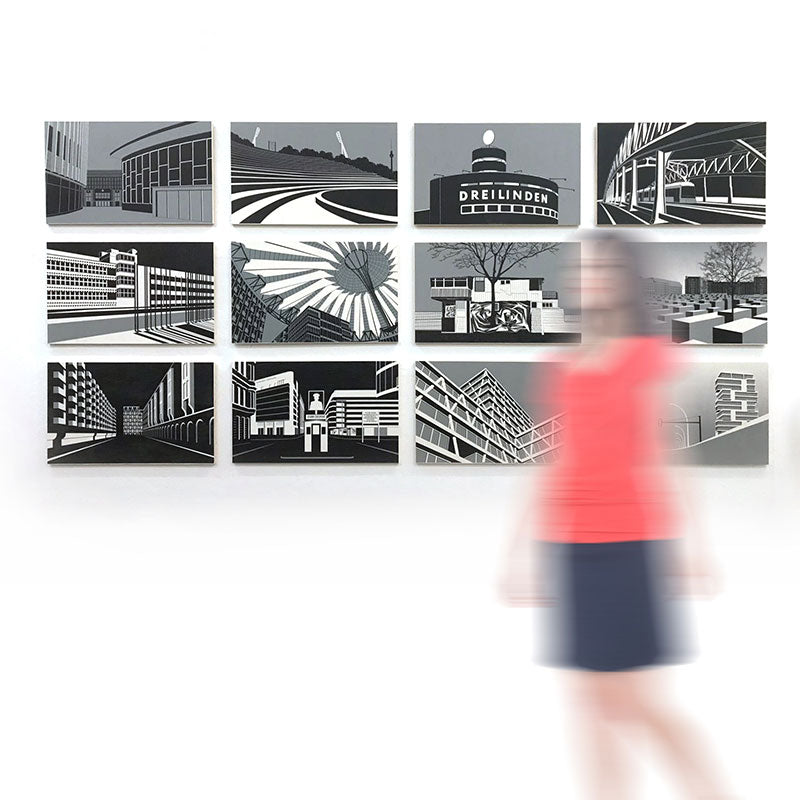
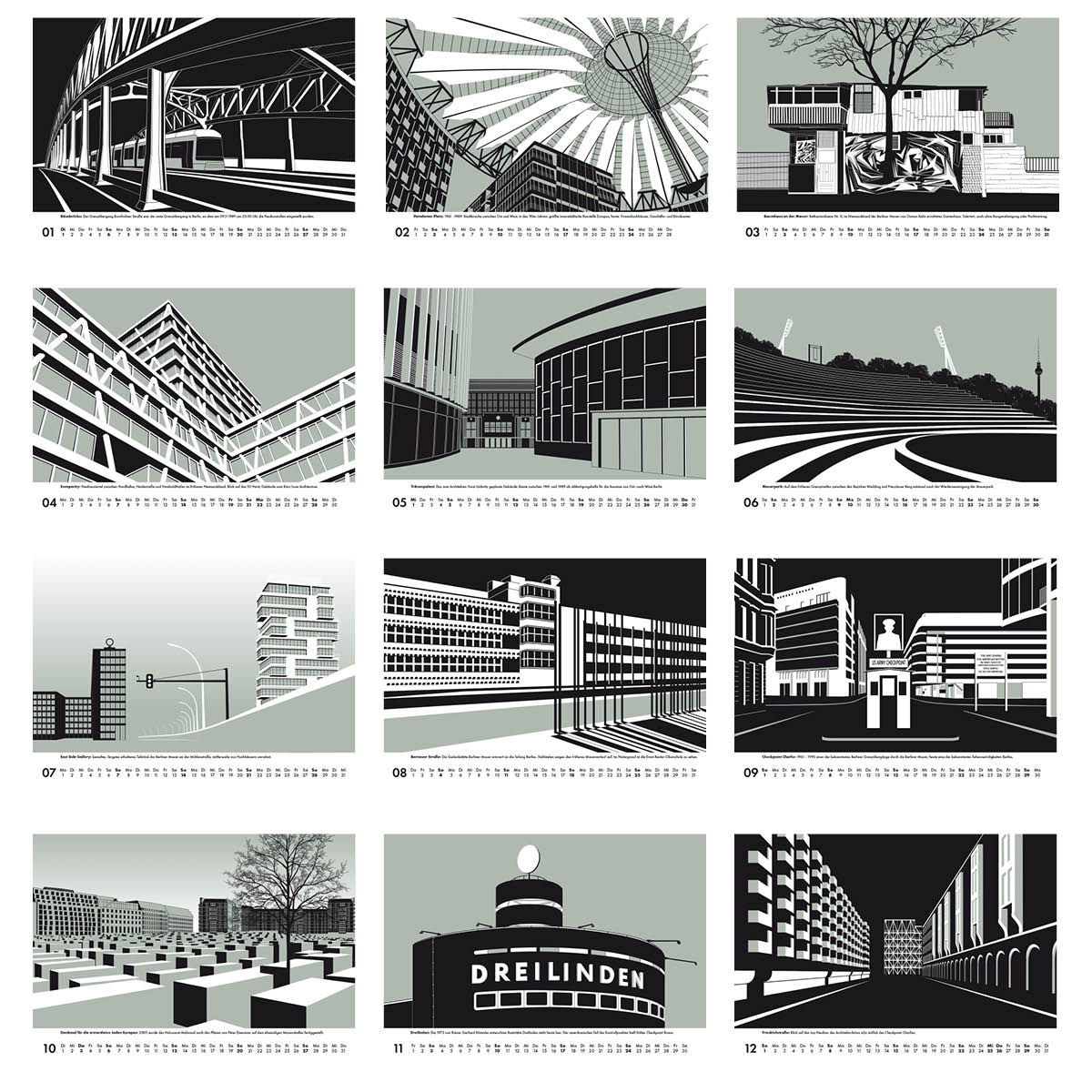
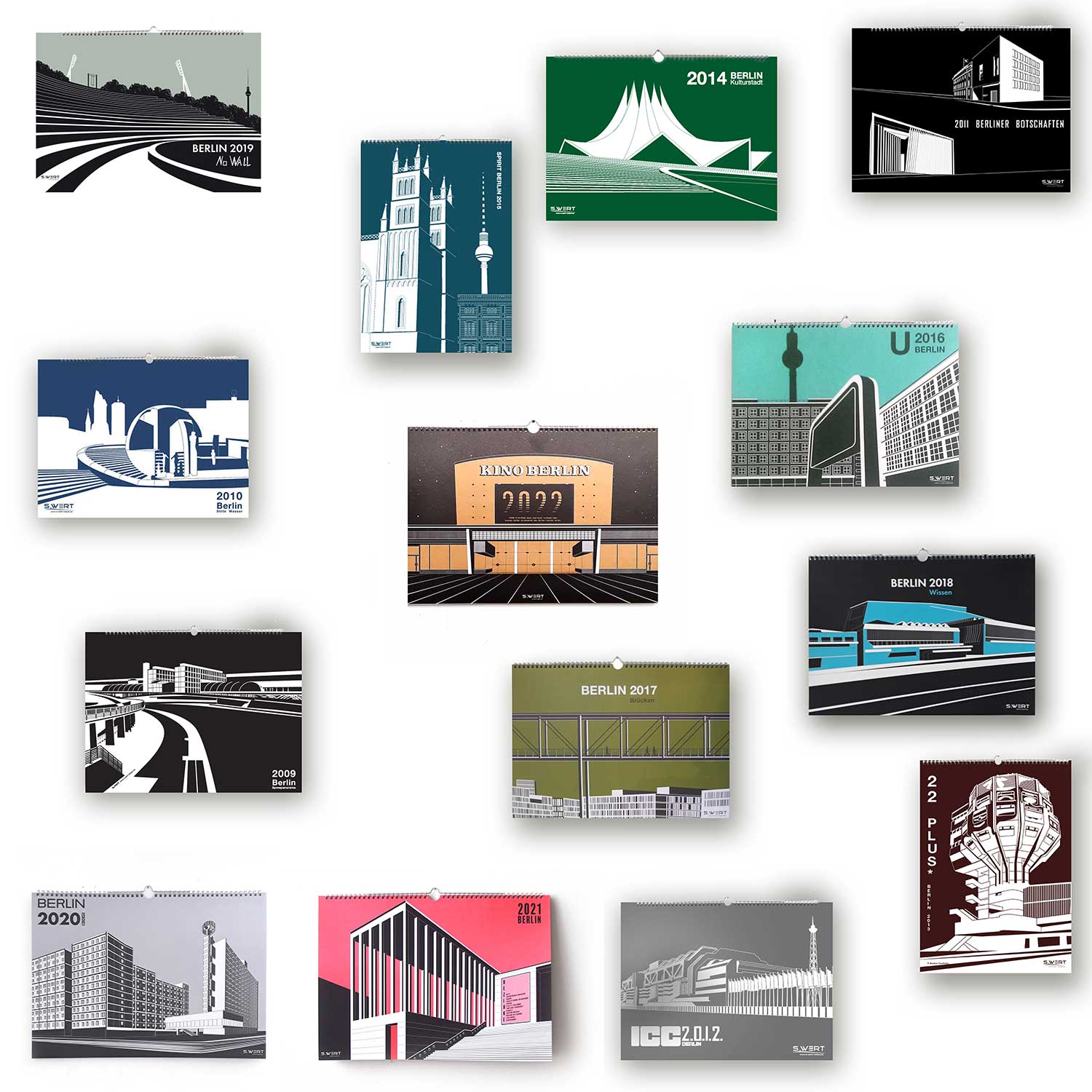
Berlin calendar
Architecture + Illustration Since 2009 we have been designing a Berlin calendar with graphic city views every year. The focus is on Berlin architecture. The calendar appears as a "LIMITED EDITION". The s.wert calendar is often sold out in December.
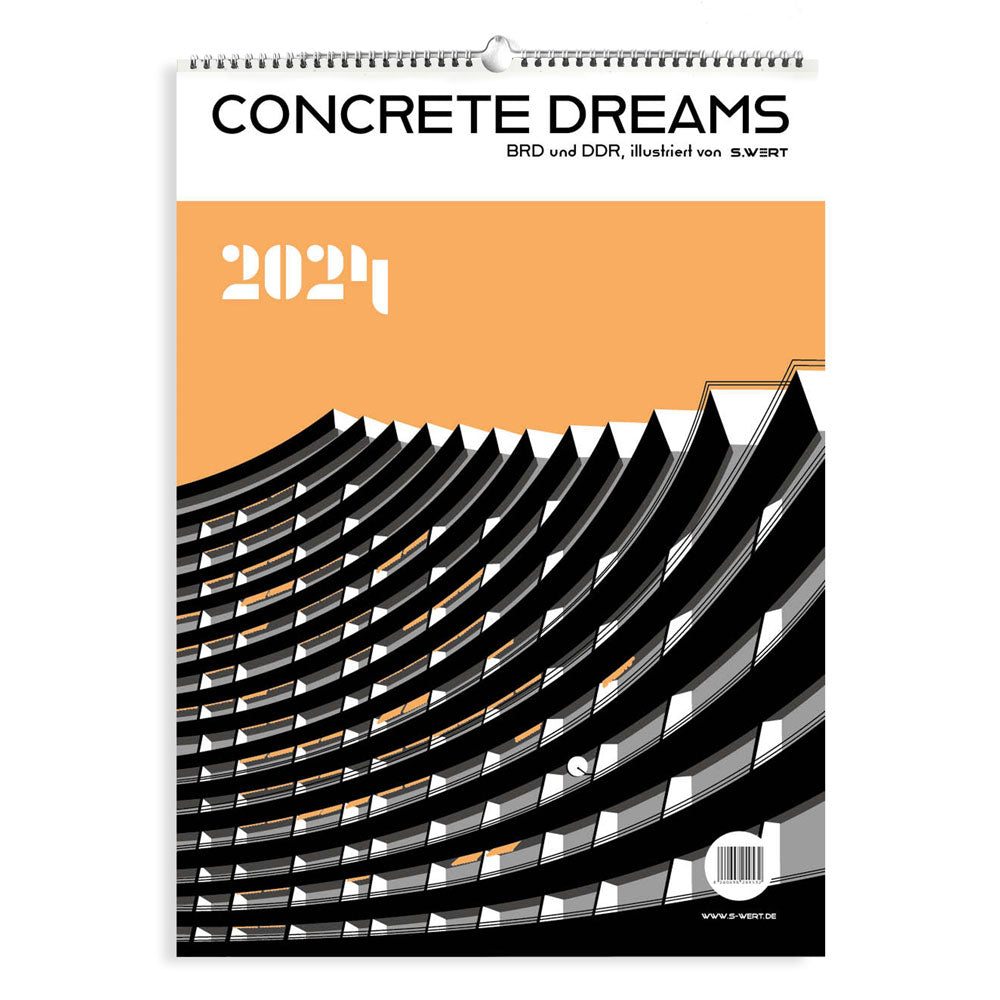
Calendar 2024 - all good things come in 3rds
We have designed three wall calendars for 2024. With attention to detail and a special focus on extraordinary architecture. In Berlin, throughout Germany and in Switzerland. For everyone who appreciates the beauty of architecture, the s.wert calendars are a must-have for the coming year!
